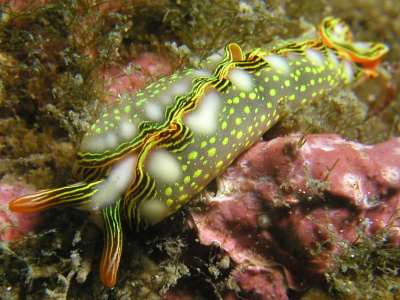
Thuridilla splendens
(Baba, 1949)
Order: SACOGLOSSA
Superfamily: ELYSIOIDEA
Family: Elysiidae
DISTRIBUTION
Probably restricted to Japanese waters
PHOTO
Tago, Suruga bay west coast of Izu peninsula, Japan, Depth: 18m, Size: approx 30mm. 5 Jun 2003. Photo: Yukari Sato
References:
• Baba, K. (1949) Opisthobranchia of Sagami Bay. Iwanami Shoten, Tokyo. 211pp + pls.
•Gosliner, T.M. (1995) The genus Thuridilla (Opisthobranchia: Elysiidae) from the tropical Indo-Pacific, with a revision of their phylogeny and systematics of the Elysiidae. Proceedings of the California Academy of Sciences, 49(1): 1-54.
Rudman, W.B., 2000 (February 16) Thuridilla splendens (Baba, 1949). [In] Sea Slug Forum. Australian Museum, Sydney. Available from http://www.seaslugforum.net/find/thursple
Related messages
Thuridilla bayeri & T. gracilis ?
February 6, 2009
From: Linda Ianniello
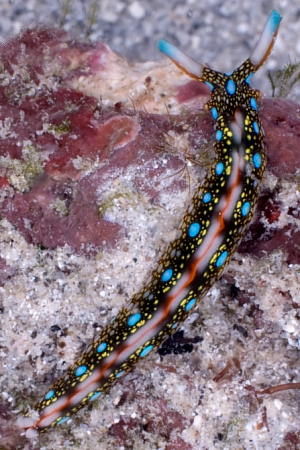
Concerning message #3077:
Dr. Bill,
attached is an image that I have not been able to identify. I believe it is a Thuridilla, and the closest I can find is an image of a T. gracilis on page 89 of "Indo-Pacific Nudibranchs and Sea Slugs". But the rhinophores don't match. And it seemed long compared to the few other Thuridilla species I've seen.
Locality: Kadavu Island, 8 feet, Fiji, Pacific Ocean, 15 May 2008, Off the beach. Length: approximately 2 inches. Photographer: Linda Ianniello.
Can you ID this one?
As usual, thanks a lot for your great forum and all the help.
Regards,
Linda I.
lindai1@bellsouth.net
Ianniello, L.M., 2009 (Feb 6) Thuridilla bayeri & T. gracilis ?. [Message in] Sea Slug Forum. Australian Museum, Sydney. Available from http://www.seaslugforum.net/find/22225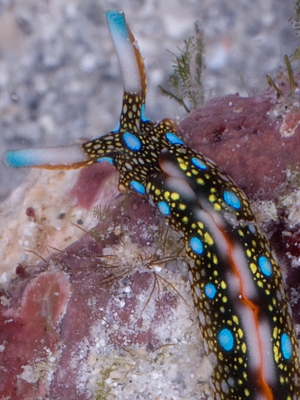
Dear Linda,
I wish I could give you a definitive answer, but your beautiful animal seems to have bits of a number of 'species'. It is probably the same as in message #2398 which I tentatively identified as Thuridilla splendens, but it also has similarities to T. bayeri which Terry Gosliner considers a good species but I suspect is a variant of T. gracilis - but the colour of the rhinophores is different to them all. It is also similar to Thuridilla sp. 3 , but I suspect all that that tells us is that we haven't quite got this group sorted out at present.
I think I will put is with T. splendens - but only because I think it would be even more confusing to have a Thuridilla sp. 5 page at present. I would welcome any thoughts?
Best wishes,
Bill Rudman
Thuridilla splendens found sthn Queensland
September 5, 2007
From: Gary Cobb
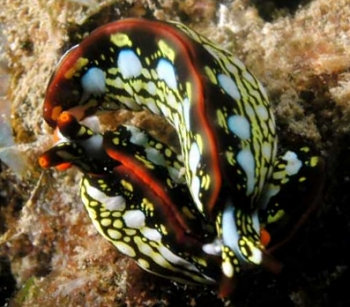
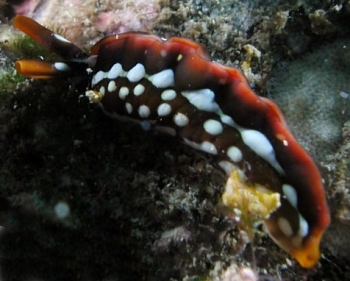
Hi Bill and everyone!
Please find pics of the most common species found here on the Sunshine Coast - Thuridilla splendens. We find them on every dive all thru the dive!
I wanted to update your records as to way this species looks here. It is much different than the ones on the Forum. Incuded is pic of an animal taken David Mullins of a darker colour version, which we have only seen once!
Locality: Mooloolaba Sunshine Coast, 5-20 m, Queensland, Australia, Pacific Ocean, The last 30 seen 01 September 2007, Subtidal. Length: 20-70 mm. Photographer: Gary Cobb and David Mullins.
Cheers,
Gary Cobb
gary@nudibranch.com.au
Cobb, G.C., 2007 (Sep 5) Thuridilla splendens found sthn Queensland. [Message in] Sea Slug Forum. Australian Museum, Sydney. Available from http://www.seaslugforum.net/find/20630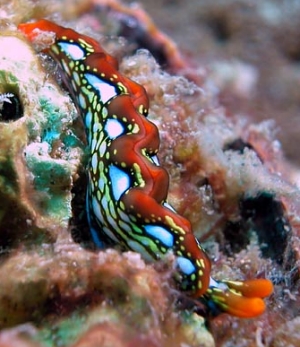
Thanks Gary,
As you will see from my earlier comments I still have some doubts about whether this is T. splendens. It is certainly rather different from the original animals described from Japan. Hopefully as we get more photos like yours from parts of the Pacific we will get a better idea of colour variation in the species.
Best wishes,
Bill Rudman
Thuridilla gracilis? from the Great Barrier Reef
March 28, 2007
From: Erik Schlögl
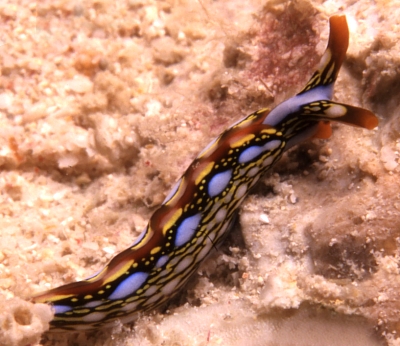
Dear Bill,
This seems to me to be another one of the many colour variations of Thuridilla gracilis - though it doesn't match any existing image in the Forum, so I can't be sure.
Locality: "URG Bommie", Great Barrier Reef off Port Douglas, 18 meters, Queensland, Australia, Pacific Ocean, 17 November 2006. Length: 8 mm. Photographer: Erik Schlögl.
Best regards,
Erik Schlögl
Erik.Schlogl@uts.edu.au
Schlögl, E., 2007 (Mar 28) Thuridilla gracilis? from the Great Barrier Reef. [Message in] Sea Slug Forum. Australian Museum, Sydney. Available from http://www.seaslugforum.net/find/19765Dear Erik,
As you will have noted from my earlier comments on T. gracilis and T. splendens, I am not entirely convinced we have the story straight on these animals. I would tend to place your animal with Thuridilla splendens, but the only way to sort out just how many species there are will be to get more specimens and a better idea of variability in colour patterns. As Clay Carlson has pointed out [message #3077], it may be useful to record the colour pattern of the inside of the parapodia as well - something not usually photographed or recorded.
Best wishes,
Bill Rudman
Thuridilla splendens? from Great Barrier Reef
October 31, 2005
From: Rachel Murphy
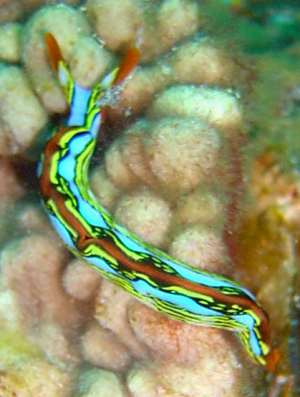
Hi Bill
I haven't posted anything in a while but seeing the discussion about Daniel Footes photo of a Thuridilla sp [#15079] has prompted me to get off my bum. I got to meet Daniel recently and it was great to meet a fellow enthusiast.
Locality: Bowden Reef, Great Barrier Reef, Queensland, Australia. Depth: 8 m. Length: 2-3 cm. 8 September 2005. reef top. Photographer: Rachel Murphy
I think it is similar to the photo by Nishina Masayoshi [#3108] which was identified as Thuridilla splendens. I am confused though by the distinct lack of spots compared to other messages for that species. This was the only individual I saw. It was quite active moving about - is it coral or a sponge?
Thanks
Rachel
rmurphy@cicr.uq.edu.au
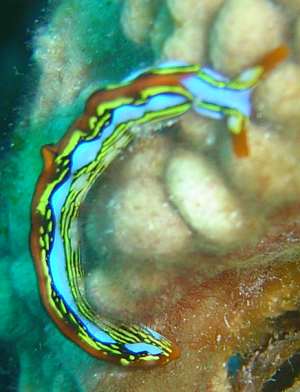
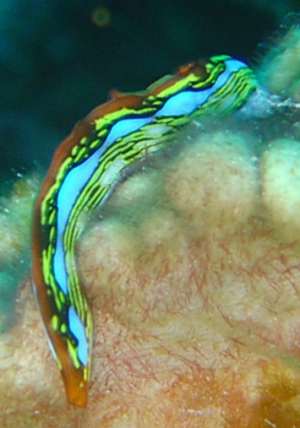
Dear Rachel,
With the proviso that I might have it quite wrong, it seems to me that T. splendens has a colour pattern which has two main variables. In Yukari Sato's message[#11398] the photos are identical in colour to Baba's original illustration, which we need to consider the 'standard', just in case there is more than one species involved. Species from Japan all appear to have this colour pattern. However in animals from the central and south Pacific the white areas become bright blue, and the yellow lines and spots can change. In messages from Hugh Dickson [#12026] and Vinka Stenhouse [#1567], both from Vanuatu, the yellow lines near the parapodial edge are replaced by spots. In Nishina Masayoshi animal from Papua New Guinea [#3108], and yours from the Great Barrier Reef, the lower yellow spots have become lines
One problem with this transition is that while Japanese speciemens have longitudinal lines along the rhinophores, the colour pattern is quite different in the blue pigmented animals from the south pacific. However Bruce Potter's photo [#4358] may represent an intermediate, with small yellow spots aranged in lines. So I guess at this stage I will consider this to be T. splendens, but hopefully we will get some more photos to compare from other participants.
Best wishes,
Bill Rudman
Thuridilla splendens from Vanuatu
February 20, 2004
From: Hugh Dickson
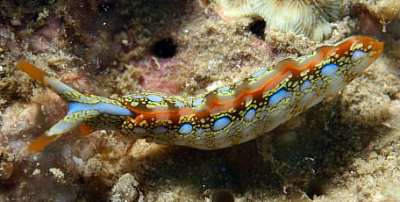
I wonder if you can ID this animal for me? I think it may be a Thuridilla.
Location is off Aore Island, Espiritu Santu, Vanuatu. Depth about 70 ft, on a silty bottom interspersed with coral heads and coral rubble. Dec 2003
Hugh Dickson
hugh.dickson@attglobal.net
Dickson, H., 2004 (Feb 20) Thuridilla splendens from Vanuatu. [Message in] Sea Slug Forum. Australian Museum, Sydney. Available from http://www.seaslugforum.net/find/12026Dear Hugh,
Yes this is a species of Thuridilla. it is Thuridilla splendens
Best wishes
Bill Rudman
Thuridilla splendens from Japan
November 16, 2003
From: Yukari Sato

Hello Dr.Rudman,
I have found this animal at Izu, Japan.
I think it is Thuridilla splendens. I am happy if you have any comment.
Upper right: 5 Jun 2003, Depth: 18m, Size: approx 30mm.Tago, Suruga bay west coast of Izu peninsula, Japan
Lower left: 5 Jun 2003, Depth: 18m, Size: approx 40mm. Tago, Suruga bay west coast of Izu peninsula, Japan
Lower right photos: 9 Apr 2003, Depth: 18m, Size: approx 30mm. Ito, Sagami bay east coast of Izu peninsula, Japan
Best regards,
Yukari Sato
yuks@cg7.so-net.ne.jp

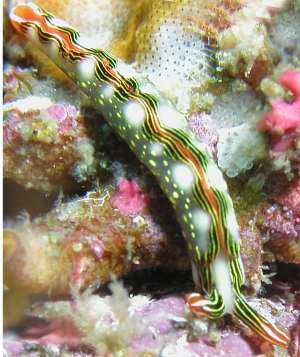
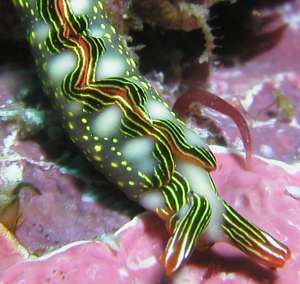
Thanks Yukari,
Your photos exactly match the original illustration [Baba, 1949]. It is good to get some photos of this species from Japan as they certainly clarify the colour apttern found in this species. Ir would seem this species may be only occur in Japanese waters and animals I have identified as T. splendens from elsewhere are most probably a different species - but at this stage I am not sure whether they are an undescribed species or part of the T. bayeri - T. ratna - T. gracilis complex.
best wishes
Bill Rudman
Thuridilla splendens from Japan
September 12, 2001
From: Yasuhiro Shirai
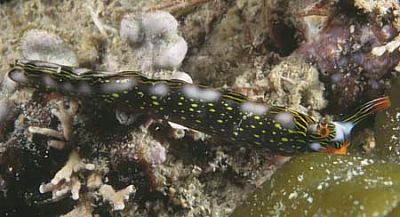
Dear Bill,
Thank you for your advice on my messages every time. I think Jun Imamoto's animal in yesterday's mesage is Thuridilla splendens. Here is a photo of Thuridilla splendens.
Data:
Shima Prefecture, Mie, central Japan., March 20,2001. Length: 25mm. Depth: -4m.
Best wishes,
Yasuhiro Shirai
yasuhiro@sea-slug.com
Shirai, Y., 2001 (Sep 12) Thuridilla splendens from Japan. [Message in] Sea Slug Forum. Australian Museum, Sydney. Available from http://www.seaslugforum.net/find/5258Dear Yasuhiro,
Thanks for the photo. I suspect your probably correct about the identity of Jun Imamoto's animal. What it had in the way of colour pattern certainly fitted, but it does lack certain features such as the blue patches, but this could be because its is still a juvenile.
Best wishes,
Bill Rudman
Elysiidae from Kerama Id, Japan (3)
September 11, 2001
From: Jun Imamoto
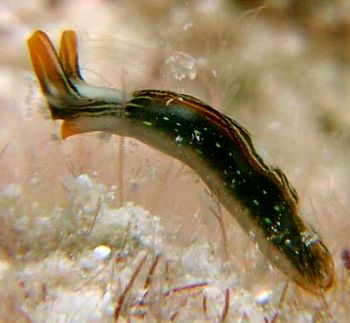
Dear Dr.Rudman,
Here is a another elysiid I photographed at Zamami, near Okinawa, Japan between July 13-17, 2001.
Length: 8mm depth: 5M
Water temp: 29-30C degree
Best Regards,
Jun Imamoto
imamoto@wips.co.jp
Imamoto, J., 2001 (Sep 11) Elysiidae from Kerama Id, Japan (3). [Message in] Sea Slug Forum. Australian Museum, Sydney. Available from http://www.seaslugforum.net/find/4980Dear Jun,
I think this is a juvenile Thuridilla. The colour of the rhinophores is quite like a number of species of that genus.
Best wishes,
Bill Rudman.
Thuridilla splendens from the Solomon Ids
June 16, 2001
From: Bruce Potter
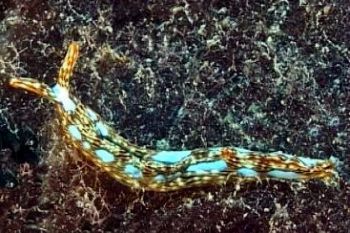
Bill,
I found this slug last Sunday at the Bonegi 1 dive site outside of Honiara, Solomon Islands. Is this Thuridilla splendens?
It would have been about 30mm long, and was at about 5meters deep. These fellows are not rare here, although I don't see them often.
Regards
Bruce Potter.
bruce.potter@adventist.org.sb
Potter, B., 2001 (Jun 16) Thuridilla splendens from the Solomon Ids. [Message in] Sea Slug Forum. Australian Museum, Sydney. Available from http://www.seaslugforum.net/find/4358Dear Bruce,
Yes this is T. splendens.
Best wishes,
Bill Rudman
Is this a species of Thuridilla
October 5, 2000
From: Nishina Masayoshi
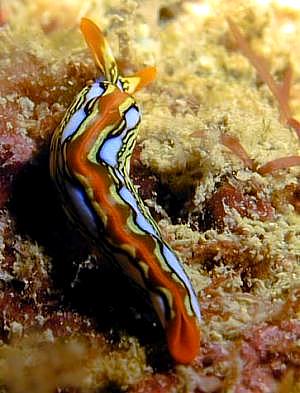
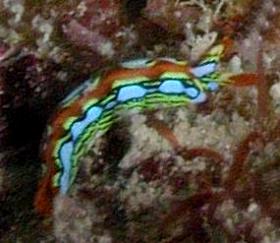
Hello Dr.Rudman!
This is Nishina from Japan.
I've been to Loloata Island, Papua New Guinea recently and saw some beautiful nudibranchs. Is this a one of colour variation of Thuridilla hopei or Thuridilla splendens?
Nishina
nishina@hep15.wips.co.jp
Masayoshi, N., 2000 (Oct 5) Is this a species of Thuridilla. [Message in] Sea Slug Forum. Australian Museum, Sydney. Available from http://www.seaslugforum.net/find/3108Dear Nishina,
This beautiful animal is Thuridilla splendens which was first described from an animal found in your country! The other species you mention, Thuridilla hopei, is only known from the Mediterranean region and as you will see from the photos of it on the Thuridilla hopei page, it has quite a different colour pattern.
Although these animals are brightly coloured and have no shell they are not 'nudibranchs'. They belong to a related Order of sea slugs called the Sacoglossa. Have a look at some of the species in the Species List belonging to the ORDER Sacoglossa. That will give you some idea of the diversity of the sacoglossan sea slugs. Some still retain an external shell, while others are a brightly coloured as their nudibranch cousins.
Best wishes,
Bill Rudman
Thuridilla splendens? from the Coral Sea
June 16, 2000
From: Stuart Hutchison
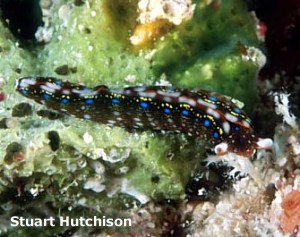
Dear Bill,
Here is another one I can't identify. It is from 8-12m in the Coral Sea.
Stuart Hutchison
hutchco@tpg.com.au
Hutchison, S., 2000 (Jun 16) Thuridilla splendens? from the Coral Sea. [Message in] Sea Slug Forum. Australian Museum, Sydney. Available from http://www.seaslugforum.net/find/2398Dear Stuart,
I am pretty sure this is Thuridilla splendens, but it is also quite similar to Thuridilla bayeri. The main differences Terry Gosliner (1995) notes in his review off the genus were a slightly enlarged pharyngeal pouch in T. splendens and yellow spots on the parapodia. The animal in your photo certainly has the yellow spots, but the parapodial edge also has light blue spots, more typical of T. splendens and smaller bright blue spots, more characteristic of T. bayeri. The rhinophores also look more like those of T. bayeri.
There is considerable variation in the colour of these two species. Because of the yellow spots I will call this T. splendens, but I am no expert on this genus, which contains some of the most colourful of the herbivorous sacoglossan slugs.
Best wishes,
Bill Rudman.
Thuridilla splendens from Vanuatu
February 17, 2000
From: Vinka Stenhouse
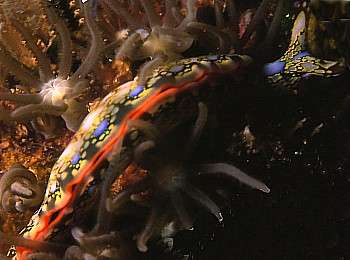
Dear Bill,
This one is Thuridilla splendens (Baba, 1949). Found at 12 metres on eastern reef slope in current prone area. Espiritu Santo Is., Vanuatu, 1998. PHOTO: Vinka Stenhouse.
Yours sincerely,
Vinka Stenhouse.
Santo.
Vanuatu.
Thanks Vinka,
The elysiids of the genus Thuridilla are truly the 'chromodorids' of the sacoglossan world.
Best wishes,
Bill Rudman.
